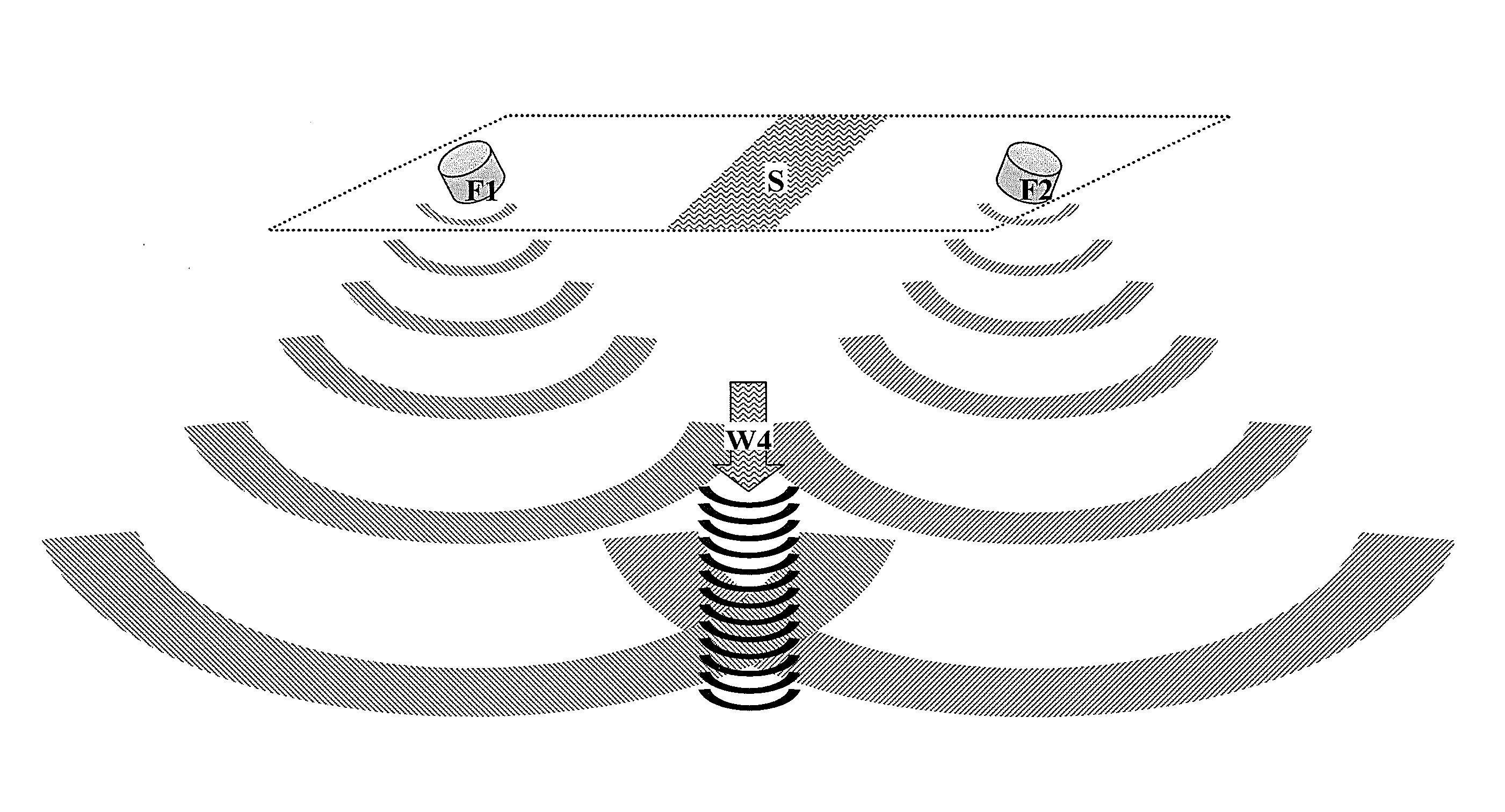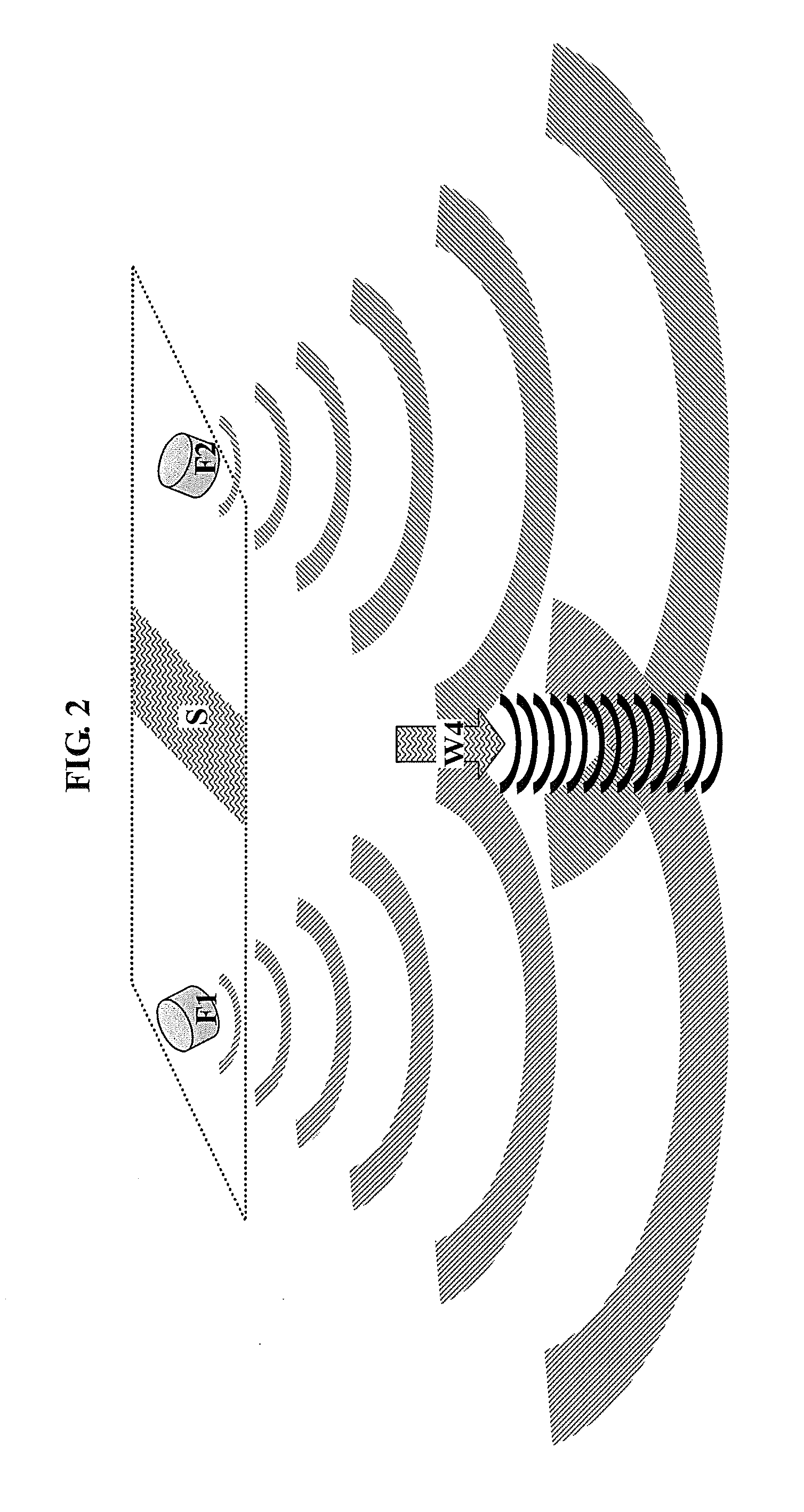Heterodyned Seismic Source
a seismic source and heterodyne technology, applied in seismology, seismicology, instruments, etc., can solve the problems of affecting marine life, physical and/or behavioral changes of these animals, and unable to provide a method to obtain geologically relevant frequencies from 0-200 hz, so as to eliminate the harmful effects of seismic surveys
- Summary
- Abstract
- Description
- Claims
- Application Information
AI Technical Summary
Benefits of technology
Problems solved by technology
Method used
Image
Examples
example 1
Heterodyned Beam
[0027]A simple array of two piezo transducers S1 and S2, with simple sine-wave signals f1 and f2 respectively. By placing S1 and S2 near each other, a set of beams is created where the two signals interfere. The resulting signal is composed of:
S′(t)=½ cos [(2π)*(f1+f2)*t]+½ cos [(2π)*(f1−f2)*t]
[0028]The signal is defined such that f1 is the first or baseline frequency, f2 is the modulating frequency, and t is time. Assuming a significant fraction of energy is propagated into the media, then the difference frequency (f1−f2) will be propagated wherever the interference beams exist. If f1 and f2 are on the order of 20 KHz, then marine life will not be affected by f1 or f2, but if they differ by 1-80 Hz, then a seismically interesting “beat” frequency will be transmitted along the beams. Thus a sweep of 1 to 80 Hz could be created by modulating f2 as a function of t.
[0029]By varying the arrays and sweeps, a very narrow, directional, and controlled beam of seismic source ...
example 2
Two Transducer Beam
[0030]As shown in FIG. 2, a side view of two transducers (f1 and f2) wherein f1 transmits a high frequency vibrational signal and f2 transmits a slightly different high frequency vibrational signal.
f1=A sin(w1t)
f2=A sin(w2t)
[0031]Due to interference, an encoded heterodyne signal is generated at the sea floor while signals in the water are well above frequencies that disturb sea life. Because these signals are generated without injuring the sensitive marine environment, the heterodyne signal can replace air-gun arrays in environmentally-sensitive areas. This allows seismic surveys in areas where governments have blocked access for seismic surveys.
example 3
Airmar Piezoelectric
[0032]As discussed in Example 2, a test apparatus is constructed using two AIRMAR M187 transducers in a tank of sea water with sound absorbing materials on the sides and bottom. Using an array of pressure sensors across the sides and bottom of the tank, energy levels and beam patterns are measured as the frequency of one of the sources is varied above and below the resonant frequency chosen for the carrier of the other source. These tests determine the relative amount of energy that can effectively be transmitted within the range required for seismic work.
PUM
 Login to View More
Login to View More Abstract
Description
Claims
Application Information
 Login to View More
Login to View More - R&D
- Intellectual Property
- Life Sciences
- Materials
- Tech Scout
- Unparalleled Data Quality
- Higher Quality Content
- 60% Fewer Hallucinations
Browse by: Latest US Patents, China's latest patents, Technical Efficacy Thesaurus, Application Domain, Technology Topic, Popular Technical Reports.
© 2025 PatSnap. All rights reserved.Legal|Privacy policy|Modern Slavery Act Transparency Statement|Sitemap|About US| Contact US: help@patsnap.com



